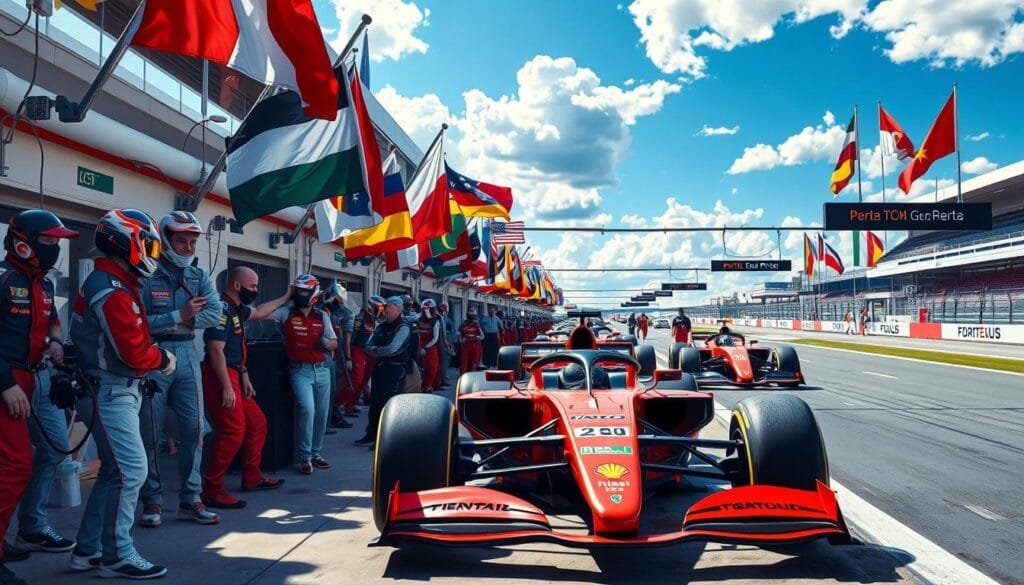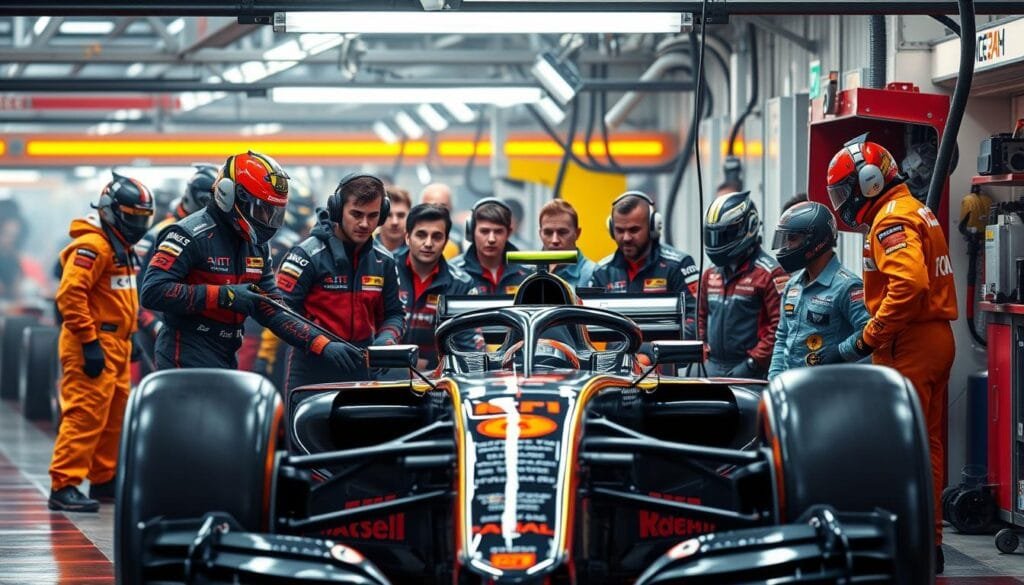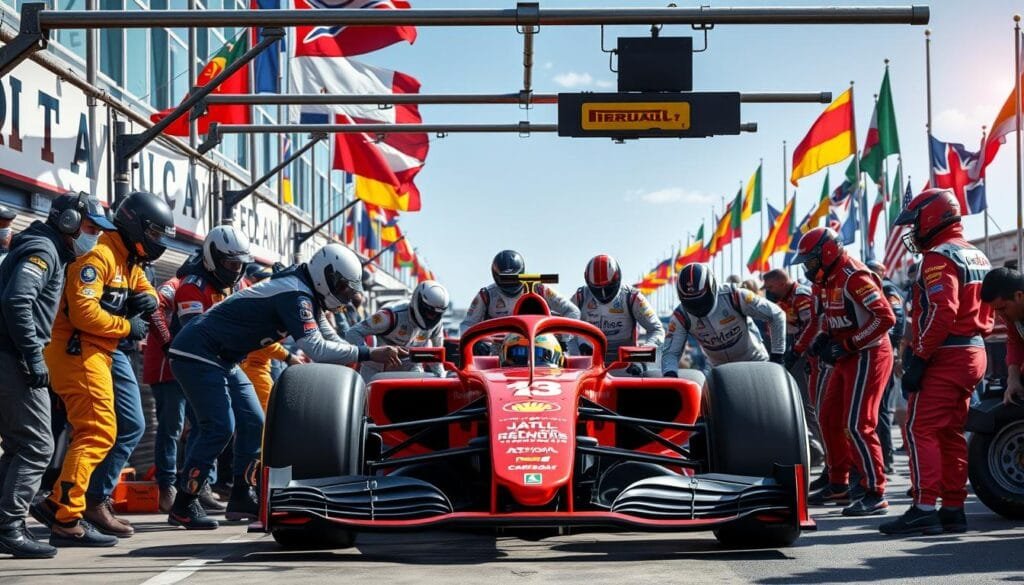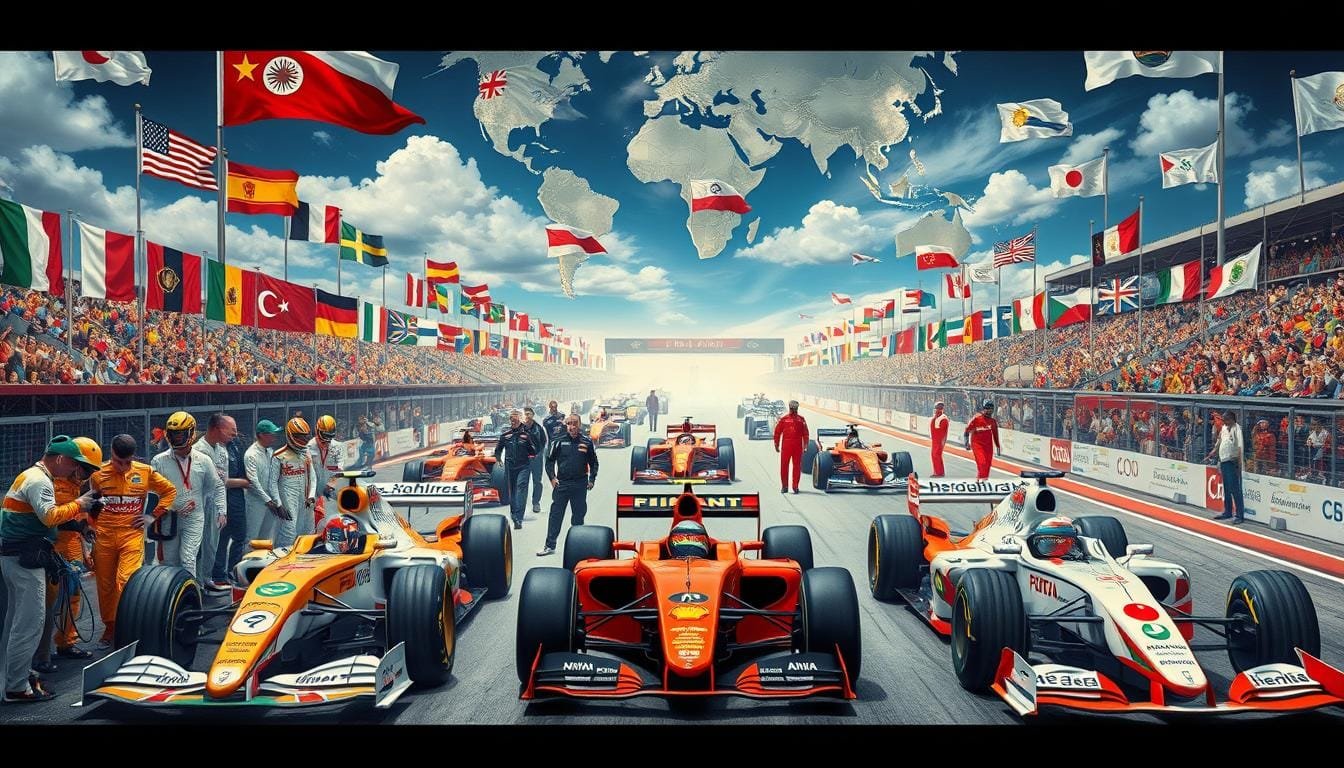What makes Formula One a global cultural hub? As the top level of motorsport, it has won many fans worldwide. It’s become a mirror of our world’s rich diversity. How does this sport blend cultural elements so seamlessly, and what effects does this have globally?
Formula One’s calendar spreads across 23 countries, making it a stage for cultural sharing. This sport uses its wide exposure to highlight host countries’ cultural events. This fosters unity and understanding across different cultures. Races like the one in Singapore attract many, boosting the local economy. Meanwhile, tracks like Yas Marina in Abu Dhabi show off Arab cultural themes in their design.
Formula One connects fans globally, celebrating diversity and pushing for inclusivity. The FIA requires teams to include women in top positions. Efforts are also being made to increase Black representation in the sport. These steps are part of a larger change towards inclusion.
Key Takeaways
- Formula One’s 2023 calendar features 23 races across various countries, increasing global exposure each year.
- The Singapore Grand Prix attracts thousands of international visitors, significantly boosting local tourism and hospitality industries.
- The Yas Marina Circuit design incorporates traditional Arab cultural elements, reflecting its heritage.
- The FIA requires each Formula One team to have at least one female member in senior management, promoting gender diversity.
- The increase in female involvement within Formula One is reshaping gender perceptions throughout the industry.
- Despite progress, only 1% of the 40,000 employees within Formula One and related organizations are from Black backgrounds.
- Over 150 institutions contributed to the upcoming report on diversity in the STEM workforce, highlighting the industry’s evolving landscape.
Introduction to Cultural Diversity in Formula One
Formula One shines as a global symbol of cultural diversity. Its reach extends worldwide, attracting various cultures into its realm. This fosters international engagement and appreciation.
Global Reach of F1
The F1 global reach is unmatched, connecting with fans across continents like the Americas and Asia. Its coverage, propelled by broadcasting innovations and social media, captivates millions. Thus, Formula One races stand out as globally watched sports events.
Formula One leads in promoting diversity and inclusion through its We Race As One campaign. A Diversity and Inclusion (D&I) charter, supported by all teams and the FIA, underlines this commitment. Learn more about their efforts here.
Highlighting Host Countries
Each Grand Prix is more than just a race; it’s a celebration of culture. Racing in different F1 host countries highlights their unique traditions and customs. From Monaco’s glam to Mexico’s vibrancy and Japan’s tech, every Grand Prix is special.
Hosting a Grand Prix significantly benefits the local economy. It supports tourism and business, much like any big international event. Formula One also works towards a sustainable future with goals for carbon neutrality and greener technologies.
Lewis Hamilton and Michael Schumacher are among the sport’s influential figures. They, alongside diversity initiatives, enrich Formula One’s cultural mosaic. Their impact, combined with the sport’s global platform, showcases Formula One’s commitment to diversity.
As it progresses, Formula One aims to enhance diversity in all areas. By welcoming diverse talents and using its platform, it stands as a champion of cultural diversity.
How is F1 Culturally Diverse
F1 races are known for cultural diversity. They bring fans and racers from around the world together. This mix of cultures and the impact of F1 races make the experience special for everyone.
Examples from Different Grand Prix
Every Grand Prix shows off F1’s cultural mix. The Singapore Grand Prix and the Abu Dhabi Grand Prix stand out. They highlight the host countries’ cultures and help their economies by bringing in tourists.
The Marina Bay Street Circuit hosts the Singapore Grand Prix. This night race mixes local culture with international styles. It draws crowds to enjoy Singapore’s food, history, and sights.
The Abu Dhabi Grand Prix takes place at Yas Marina Circuit. It blends Middle Eastern culture with racing thrills. Visitors come for the race and stay to explore the luxury and history of the UAE.
Impact on Tourism
Grand Prix events boost tourism, helping the local economy. They attract international visitors who spend money on hotels, food, and fun. This benefits both F1 and the host cities by increasing cultural interactions.
Tourist inflow from these events means more business for local shops and a stronger economy. The media attention also puts host cities on the map, possibly attracting more tourists and investors later on.
F1’s blend of tourism and cultural diversity enriches the experience for viewers. It also brings great benefits to host places. By uniting people from around the globe, F1 promotes cultural sharing and economic growth.
Cultural Exchange and Formula One
Formula One (F1) is now a global event, bringing people together. Diverse groups meet at Grand Prix races. They share and learn about different cultures.
Bringing Together Diverse Groups
F1 attracts fans worldwide, celebrating cultural diversity in sports. In the U.S., 28% of adults, or 72 million people, are fans. More than half started watching because of “Drive to Survive.”

Creating a Safe Environment for Fans
F1 works hard to make everyone feel welcome. Now, almost 40% of fans are women, up from 8% in 2017. F1 events, like the U.S. Grand Prix in Austin, boost the local economy.
They also lead to better local facilities. This makes F1 events more open to fans from around the world. Everyone can enjoy the races together.
| Statistic | Impact |
|---|---|
| 28% of American adults as F1 fans | Increased cultural exchange |
| 50% credit “Drive to Survive” | Greater diversity in sports |
| Female fans rose from 8% to 40% | More inclusive environments in F1 |
| U.S. Grand Prix boosts local economy | Enhanced community engagement |
Gender Equality in F1
Formula One has seen the need to better gender equality, focusing on reducing gaps and boosting inclusivity. We’re deeply committed to F1 gender diversity. This has led to great strides in various aspects of the sport.
The mix of men and women working in Formula 1 has changed a lot lately:
| Year | Male | Female |
|---|---|---|
| 2018 | 72% | 28% |
| 2022 | 69% | 31% |

We’re working hard to make things better for women in motorsport. The gender pay gap is shrinking. It went from 25.1% in 2018 to 20.2% in 2022. This shows we’re moving toward more equality in sports.
It’s not just about numbers. Women’s roles in leadership and key decisions have grown. Monisha Kaltenborn and Claire Williams have held top positions. Hannah Schmitz’s role for Max Verstappen also highlights women’s expanding influence.
Programs like the FIA’s Girls on Track and the F1 Academy support women in motorsport. Scholarships and workshops help more women get involved and succeed in racing.
Formula One is tackling challenges with a complete strategy. We’re updating HR practices and training staff on Diversity & Inclusion. By working with experts and holding bi-weekly group meetings, we’re making our environment more welcoming.
In the end, our goal is to make gender equality a real achievement in Formula One. We’re working towards a future where it’s an established fact.
Challenges in Diversity and Inclusion
Formula One is very popular around the world. But, it still struggles with significant F1 diversity challenges. Structural and cultural barriers make it hard for diverse groups to join in fully.

Structural and Cultural Problems
The path to diversity and inclusion in motorsports is complex. Here are some concerning statistics:
- Less than 1% of individuals in F1 are from Black backgrounds.
- Only two women have ever been team principals in F1.
- F1 has never had a Black team principal.
- It could take 200 years for UK’s top firms to reflect population diversity.
These stats show a need for big changes. The Federation Internationale de l’Automobile (FIA) is working on it. They represent over 80 million people globally. But, we need to do more to break down the barriers in the sport.
Lewis Hamilton’s Advocacy
Lewis Hamilton is making history in motorsports. He’s the first and only Black driver to win in F1. He shines a light on inclusion in motorsports issues. Hamilton started the Hamilton Commission, making 10 recommendations to boost diversity. The Hamilton Commission and Accelerate 25 show his commitment.
His work for diversity is also seen in Mercedes’ team decisions. They showed support with a Black livery on their F1 car for two seasons. Their goal is for 25% of new hires to be from underrepresented groups by 2025. They’re also providing bias and diversity training to their staff. Lewis Hamilton’s efforts are a big step forward.
We should celebrate actions like Hamilton’s, aiming to end inequality in F1. A strong ongoing push for diversity and inclusion will change motorsport for the better.
LGBTQ+ Representation in F1
LGBTQ+ visibility in Formula One was limited for a long time. The scene changed with Ralf Schumacher coming out. As a high-profile F1 driver, his announcement was significant. It sparked new discussions on inclusivity and representation in the sport.
Ralf Schumacher’s Impact
Ralf Schumacher’s coming out has led to talks about LGBTQ+ in F1. He competed from 1997 to 2007, winning six races and getting on the podium 27 times. His openness helps promote inclusive sports environments.
Organizations Promoting LGBTQ+ Inclusivity
Organizations like Racing Pride play a big role in promoting LGBTQ+ inclusivity in F1. They work to boost LGBTQ+ visibility. They also provide initiatives and workshops for better understanding and allyship. For example, Racing Pride’s workshops share LGBTQ+ experiences.
The Mercedes-AMG PETRONAS F1 Team shows how teams can support inclusivity. They run Pride-themed events and activities all year. This helps raise awareness and support for LGBTQ+ individuals.
Conclusion
Exploring cultural diversity in Formula One shows us how it promotes inclusion. The sport’s global reach, with races across continents, unites different cultures. Formula One is more than racing; it’s a powerful force for cultural progress.
The sport is advancing in gender equality and LGBTQ+ representation. It uses Grand Prix events for cultural exchanges. Figures like Lewis Hamilton push for social change, showing the need for continued advocacy.
Partnerships, like the $1 billion deal with LVMH, aim to make F1 more inclusive. These efforts show a commitment to keeping the sport culturally relevant.
Formula One doesn’t just entertain; it educates and inspires. By valuing diversity and inclusion, it leads in promoting inclusion in sports. As it grows, its influence on positive change expands, celebrating cultural diversity worldwide.
FAQ
How does Formula One promote cultural diversity?
Formula One highlights cultural diversity by having races in 23 countries. Each country showcases its unique culture and traditions. This approach not only honors the uniqueness of each location but also fosters global harmony through cultural exchange.
What is the global reach of Formula One?
Formula One races take place all over the world. Its global presence shines a light on various cultures, highlighting their unique features. This international exposure celebrates traditions and innovations, boosting global interest.
Can you give examples of F1’s impact on tourism?
Events like the Singapore and Abu Dhabi Grand Prix boost tourism. These races draw visitors worldwide. They come to experience thrilling races and explore local culture and cuisine. This, in turn, supports the local economy and fosters cultural appreciation.
How does F1 facilitate cultural exchange among fans?
F1 brings fans from diverse backgrounds together. They share a love for motorsport. This sharing promotes understanding and respect, making F1 a welcoming space for everyone.
What initiatives has Formula One taken to promote gender equality?
Formula One champions gender equality by involving more women in the sport. Women are stepping into leadership and other crucial roles. Efforts are being made to empower women. This shows F1’s commitment to ending gender disparities.
What challenges does Formula One face in terms of diversity and inclusion?
F1’s effort to become more inclusive faces some hurdles. Structural and cultural issues limit participation from underrepresented groups. Yet, actions by figures like Lewis Hamilton highlight progress towards inclusivity.
How has LGBTQ+ representation improved in Formula One?
Ralf Schumacher coming out is a milestone for LGBTQ+ representation in F1. Groups like Racing Pride champion inclusivity. They push for visibility and support for the LGBTQ+ community, enhancing F1’s welcoming atmosphere.
How does F1 create a safe environment for its fans?
F1 prioritizes safety and inclusivity for fans. Safety protocols are in place at events. Efforts ensure everyone feels respected and welcome, regardless of origin or identity, nurturing a culture of respect.
